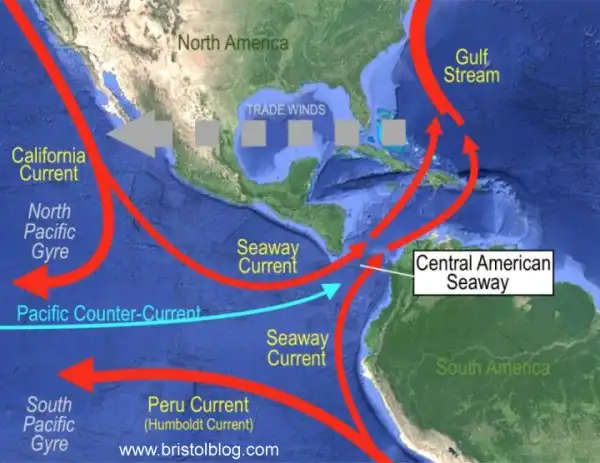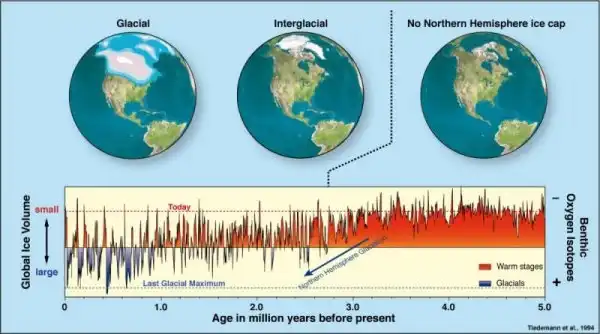
Giant camels that once lived in the Arctic.
Click for larger image.
We Still Live in an Ice Age
by Lewis Loflin
Follow @Lewis90068157
Related see Mastodons Roamed Greenland 2 Million Years Ago
(Above) About 2.6 million years ago (MYA) the northern hemisphere entered the Pleistocene Ice Age with short interglacials. Forests and wildlife such as these giant camels extended above the present arctic circle. Today those forests and animals are gone replaced by barren tundra.
Three million years ago, the northern hemisphere was ice-free and far warmer - no, it was NOT CO2 levels. Things changed when the Isthmus of Panama closed, connecting North and South America. This land bridge was due to plate tectonics. An exchange of animals from both continents led to the extinction of some mammals and large flightless birds. That is how we got the Virginia opossum that originated in South America.
The real damage was the change in ocean currents, particularly the exchange of warm water between the Pacific and Atlantic oceans. When the Northern Hemisphere cooled, millions of mammals, birds, and reptiles went extinct while vast forests died. The high latitudes are mostly barren today. Cooling causes mass extinctions more than warming.

Central American Seaway 3 million years ago.
Click for larger image.
My hypothesis is when the Central American Seaway closed, warm water currents from the Pacific no longer joined with the Atlantic current to warm the Arctic. Refer to the above illustration. This idea is my opinion, and likely someone else thought of it before, and there is still debate on just how long ago this occurred.

Change Northern Hemisphere ice cover over 5 million years.
Click here for a larger image.
The figure above illustrates changes over the last 5 million from warm (nothing to do with CO2) to producing ice ages today. Presently, we are in the Holocene interglacial that began 11,700 years ago.
Between 9,000 and 7,000 years ago, forests regrew in Eurasia to the Arctic Ocean during the Holocene Climate Optimum. It then cooled to present temperatures. Climate activists struggle to play these facts down or ignore them.
The last 1 million years has been mainly ice ages with brief interglacials. It would be far better to return to the climate the giant camels that died out in Canada once enjoyed.
Holocene Treeline History and Climate Change Across Northern Eurasia
Published online by Cambridge University Press: 20 January 2017
Ref. https://doi.org/10.1006/qres.1999.2123 Abstract:
Radiocarbon-dated macrofossils are used to document Holocene treeline history across northern Russia (including Siberia). Boreal forest development in this region commenced by 10,000 yr B.P. Over most of Russia, forest advanced to or near the current arctic coastline between 9000 and 7000 yr B.P. and retreated to its present position by between 4000 and 3000 yr B.P. Forest establishment and retreat was roughly synchronous across most of northern Russia.
Treeline advance on the Kola Peninsula, however, appears to have occurred later than in other regions. During the period of maximum forest extension, the mean July temperatures along the northern coastline of Russia may have been 2.5° to 7.0°C warmer than modern. The development of forest and expansion of treeline likely reflects a number of complimentary environmental conditions, including heightened summer insolation, the demise of Eurasian ice sheets, reduced sea-ice cover, greater continentality with eustatically lower sea level, and extreme Arctic penetration of warm North Atlantic waters. The late Holocene retreat of Eurasian treeline coincides with declining summer insolation, cooling arctic waters, and neoglaciation.
- Answering the Eco-Luddites
- Eco-Theology in Public Schools Violates Constitution
- Environmentalism Dominated by Unwitting Religiosity
- Ocean Currents Control Climate
- We Still Live in an Ice Age
- Observing Nature in the Real World
- Venus was Never Like Earth Science is Never Settled
- Mastodons Roamed Greenland 2 Million Years Ago
- Present Global Warming Began Circa 1800
- Dissecting Critical Climate Theory
- $1.5 Trillion Climate Change Industrial Complex
- Climate Change Cover for Spiritual & Social Revolution
- Corporate Welfare Grifters Climate Non-Crisis
- When Mythology Replaces Science
- Facts on Hurricanes and Tornadoes Past Present
- Why we should not fear nuclear power.
- Nuclear Graveyards Abound with Life
- What About Humans and Nuclear Radiation?
- Radiation Basics They Should Teach in High School
- How Woke Racism is Killing Education
- What PISA Scores Reveal About Immigration
- Deranged California Teacher Obsesses Over Race
- Lack of Ability is Not Systemic Racism
- Chicago Schools Ruined by Racial Diversity
- Michigan Muslim-Black Problem in Education
- Electronics, Nuclear Reactors, Applied Science
- Electronics and Technology Built at Home
My other websites are as follows:
- www.bristolblog.com Skeptic Site
- www.bristolwatch.com Electronics Tutorials
- www.sullivan-county.com Religious History, Appalachian issues
- Off Site:
- Web Master
- Tri-Cities VA-TN
- General Science
- Hobby Electronics
- US Constitution
- Christianity 101
- Religious Themes
Web site Copyright Lewis Loflin, All rights reserved.
If using this material on another site, please provide a link back to my site.